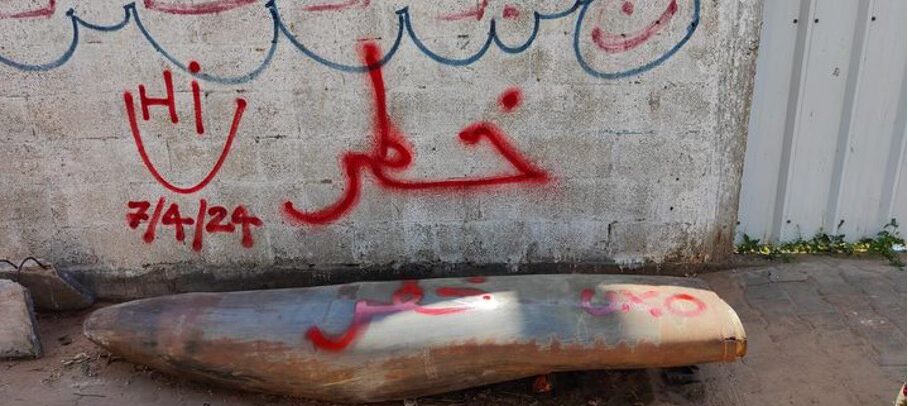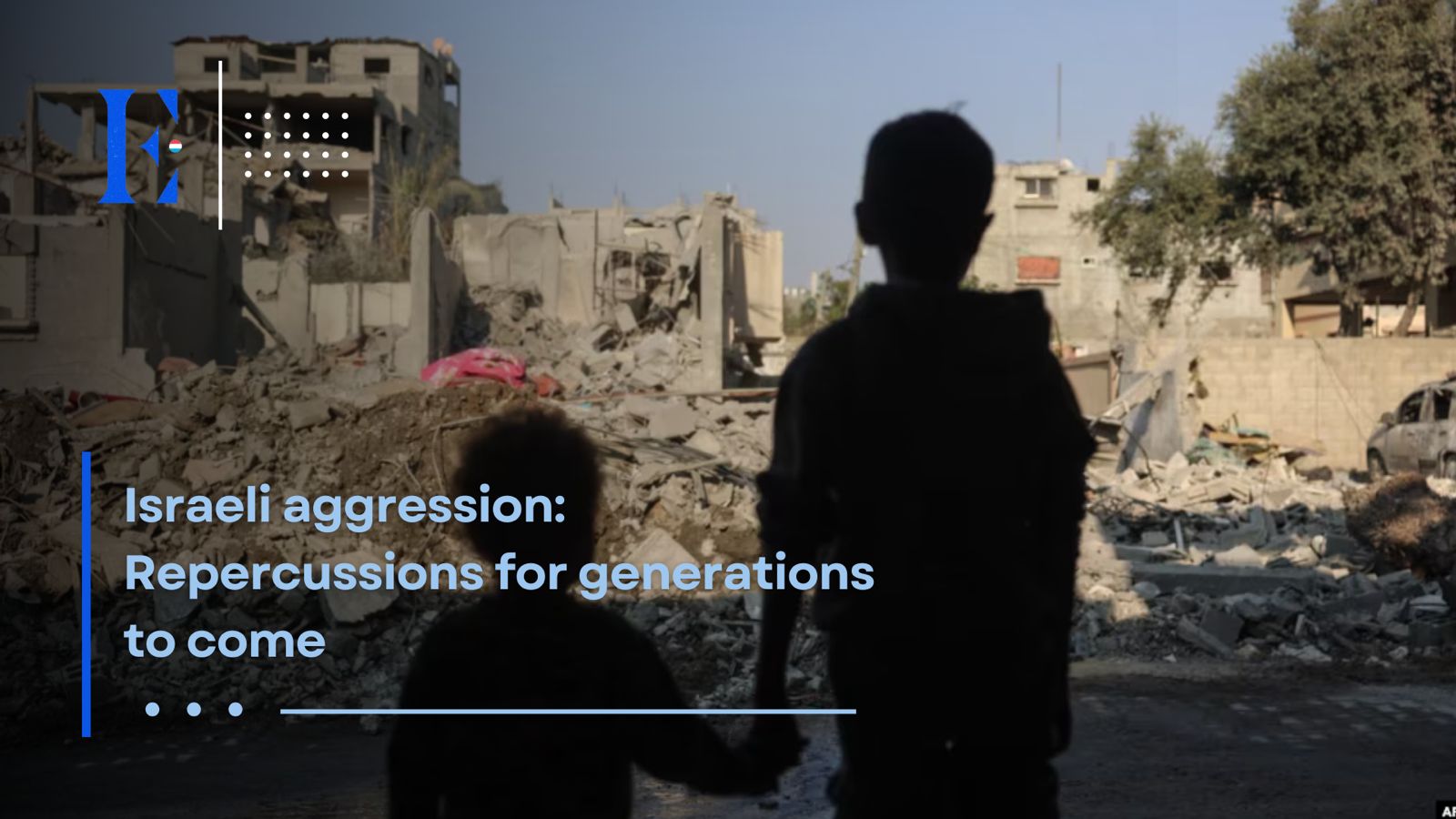Israel’s uninterrupted bombing of Gaza for over a year has killed over 43.000 Palestinians, many of whom are children and women, and injured at least 100.000. The death toll in Isreal remains at around 1.200 with at least 5.000 injured, according to the United Nations Office for the Coordination of Humanitarian Affairs (OCHA)[1].
Following Israel’s aerial and land offensive, 90% of the Gazan population has been displaced. Some Palestinians live in tents while others live in converted shelters such as schools or hospitals which are subject to regular striking by Israeli aggression, as stated in a report by the Office of the United Nations High Commissioner for Human Rights (OHCHR).
Trauma embedded in their DNA
A less investigated problem is in relation to Gaza’s future children who will inherit the trauma. The already present Transgenerational Trauma that is due to the occupation of Palestinian land for over half a century is intensified.
The aftermath of high-impact weaponry such as continuous airstrikes and the illegal use of white phosphorus as a war weapon not only has devastating results on Palestinians currently living in Gaza but also affects multiple generations to come. A report by the OHCHR confirmed the use of white phosphorus through an incident of a toddler burnt by it in Al Bureij Camp in Gaza.
Studies have shown that the descendants of the Holocaust, the Rwandan Genocide, and the Vietnam War survivors are indeed affected by multigenerational trauma. Another study on unborn babies who survived the Dutch famine in the womb concluded that the foetuses had an increased risk of developing breast cancer, obesity, had smaller brain volumes, and were more sensible to stress. A more shocking finding was that even the grandchildren of the pregnant women who survived the famine had increased health issues and impaired cognitive abilities.
Palestinians are currently facing famine and it affects the most vulnerable, namely infants and elderly people. Israeli authorities as well as Israeli civilians are reportedly blocking humanitarian aid from entering Gaza and occasionally destroy food packages. Save the Children reports that 83% of food aid does not enter Gaza, consequently, around 50.000 children are malnourished. Over 1 million people in southern and central Gaza did not receive any food rations in August.
Out of 36 hospitals, only 17 remain partly functional. Medical equipment is scarce, as well as medical personnel, therefore the immense demand of medical attention cannot be met. A collapsed health care system furthermore leads to the inability to treat the injured and ill properly, which leads to lifelong injuries and the emergence of diseases.
Gaza won’t be cleared of the bombs in our lifetimes
The exact number of bombs, missiles, grenades, and artillery launched by Israel for over a year remains unknown. However, around 10-12 % of the devices generally do not detonate, says bomb disposal expert Nicholas Orr.
He regularly saw children in Gaza play with unexploded shelling, which are literal “ticking time bombs”. He informs us that without a permanent ceasefire, it will be impossible to demine Gaza since there are no adequate safety conditions to remove unexploded bombs. The removal, however, would take decades. ‘It won’t be done in our lifetimes. It’s been 80 years since World War Two and we are still clearing ordnance from the European mainland and the UK’, concludes Orr.

20 minutes. Regny Diane, ‘Guerre Hamas-Israël’ <https://www.20minutes.fr/monde/israel/4111186-20240920-guerre-hamas-israel-gaza-decouvert-bombe-1-000-kg-laquelle-enfants-jouaient>
Orr wrote the word “danger” in Arabic on unexploded shells whenever he saw them to prevent people from trying to move them. One of the unexploded devices was a bomb of 1.000 kg, which could have blown up a whole district and a displacement camp.
UNMAS[2] estimates that the removal of the massive debris left by the explosives as well as the unexploded weapons would take 14 years at the least. Currently, Orr’s priority is clearing public spaces from danger because some of Gaza’s destroyed buildings are still inhabited and pose a danger to civilians.
Psychological trauma follows survival
The surviving Palestinians suffer from starvation, chronic traumatic stress disorder, anxiety and/or depression, health issues, and lifelong injuries such as amputations. Restoring Gazan economy will be another challenging mission since most of the infrastructure was destroyed and businesses cannot function anymore. Moreover, Gaza’s water, soil, food, and environment contain toxicities from Israeli weaponry which make living there dangerous.
The continuous bombing of residential buildings oftentimes kills whole families. In fact, 43 families have lost more than 30 family members. The Al Najjar family had 138 family members killed. These numbers may very well be even higher, concludes the OHCHR.
References
Atmos Earth. ‘How Gaza’s Future Children Will Inherit the Trauma of Genocide’, 10 August 2024
<https://atmos.earth/how-gazas-future-children-will-inherit-the-trauma-of-genocide/>
BBC. Cursino Malu, ‘Israeli protesters block aid trucks destined for Gaza‘, 14 May 2024
<https://www.bbc.com/news/articles/cg300jek94zo>
Geneva Solutions. Jefford Kasmira, ‘Gaza’s unexploded bombs’, 11 October 2024
Norwegian Refugee Council. ‘Israel’s siege now blocks 83% of food aid reaching Gaza, new data reveals’, 16 September 2024
‘Reported impact since 7 October 2023’<https://www.ochaopt.org>
United Nations News. ‘Gaza’s unexploded ordnance could take 14 years to clear‘
<https://news.un.org/en/story/2024/04/1149051>
Update Report on the human rights situation in Gaza, 8 November 2024
Save the Children. ‘Israel’s siege now blocks 83% of food aid reaching Gaza, new data reveals’
20 minutes. Regny Diane, ‘Guerre Hamas-Israël’, 10 September 2024
[2] United Nations Mine Action Service
[1] The OCHA shares data on people affected by a crisis and what they specifically need as well as how to help them in the most effective way. The OCHA was created to ensure adequate and organised help for humanitarian emergencies by bringing together different humanitarian actors and depends greatly on voluntary contributions, which mainly come from governments. Their primary donors are Sweden and the UK.


Thank you for raising this issue. It is a brilliant, super informative article that should be read. Thank you!
Ech fannen dat gudd,dass och iwwert Gaza geschwaat gett. Den Artikel ass wierklech mega gudd ginn.👍🏼👍🏼
Een fantasteschen Artikel, dass doriwer och emol geschwaat gett.
All Respekt.
The structure was clear, and the topics you covered were both engaging and informative. I really appreciated the details about the current situation in Gaza you included, and your writing style is very captivating, drawing the reader in. I’m sure many people will find it interesting! Keep up the great work!
Best regards Jolynn from Diekirch 🙂